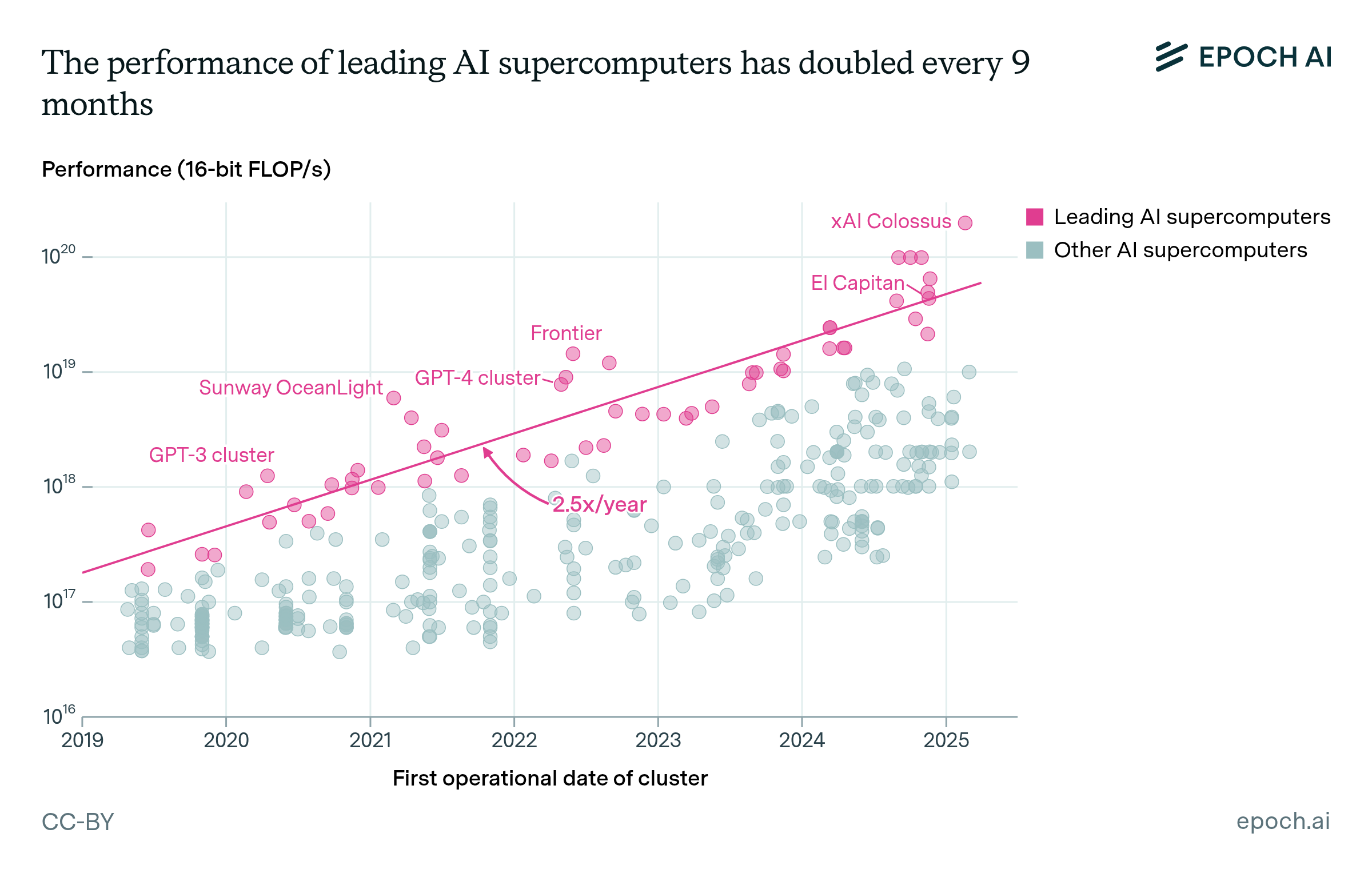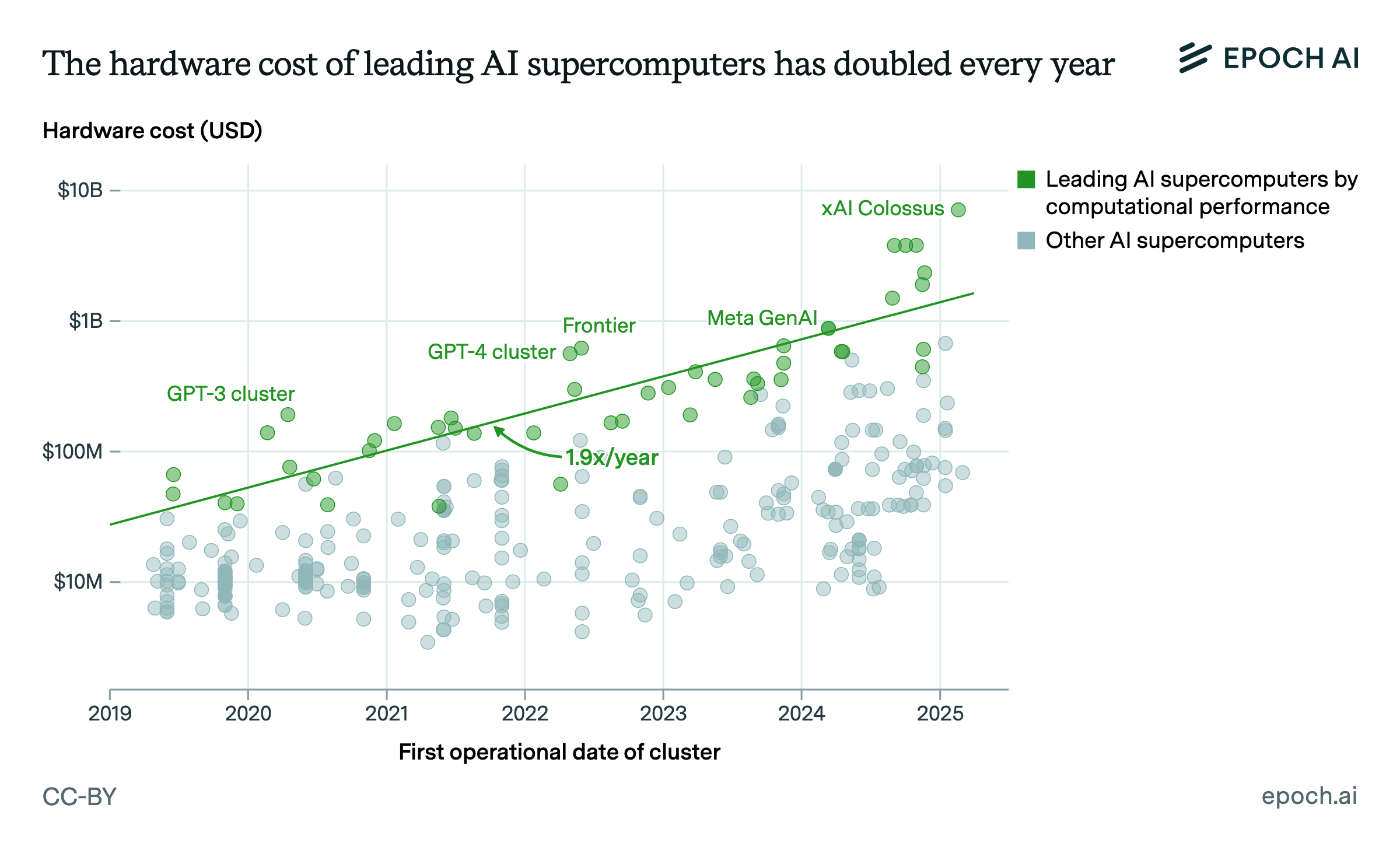Build times for gigawatt-scale data centers can be 2 years or less
Gigawatt-scale AI data centers are massive undertakings, requiring extensive permitting, construction, and power infrastructure. Nevertheless, many hyperscalers have concrete plans to build data centers at this scale in 2 years or less.

Among the facilities we track that broke ground in the past 3 years, the time from starting construction to achieving 1 GW of total facility power ranges from 1 to 3.6 years1, with xAI projecting just 12 months to build Colossus 2. We expect the first GW scale datacenters to come online in early 2026.
Authors
Published
November 10, 2025
Explore this data
Learn more
Overview
We track the development timelines of frontier AI data centers to measure how long they take to reach gigawatt scale after starting construction. Using satellite imagery and permits, as well as company disclosures, we compile construction and power milestones for major U.S. datacenter campuses including xAI’s Colossus 2 and OpenAI’s Stargate. Given that updates occur intermittently through filings or new imagery, each milestone is the earliest point at which a site is expected to have reached that threshold. These timelines help illustrate the speed and scale of the compute capacity coming online across the U.S.
Data
AI data center buildout data is taken from the Frontier Data Centers Hub, which tracks the largest AI data centers in the United States.
For each facility, we identify three key milestones:
- Construction kickoff: the start of visible land clearing or construction, verified via satellite imagery or local permits.
- First operational: the first indication of live electrical load or operation, inferred from official documents and/or imagery of a finished building with cooling and power equipment. We assume a default 150-day lag from building roof completion and this milestone, which reflects the typical time required for interior fit-out, rack installation, and network integration. However, if cooling systems or power infrastructure are not yet in place within 150 days, we defer our “first operational” estimate until there is evidence of cooling and power.
- 1 GW Threshold: the earliest point at which total facility power reaches or exceeds 1 GW. This does not indicate full campus completion, only that at least 1 GW is online. We estimate this date using official documents, company disclosures, and on-site construction progress seen through satellite imagery. We estimate power capacity for different buildings and points in time using our cooling and compute models.
The dataset currently covers a subset of U.S. facilities publicly confirmed or strongly evidenced to host AI training clusters, including projects by Amazon, OpenAI, xAI, and Microsoft. Additional details on our data collection process, methodology, and limitations can be found in the Frontier Data Center Hub documentation.
Analysis
To estimate time-to-power milestones, we calculate the duration between the start of construction to first power as well as the duration between first power to reaching 1 GW of facility power capacity.
Our milestone dates are based on the earliest available data points that meet each threshold. Air quality, water, and building permits provide snapshots or projections of construction progress and scale, but the data is not continuous. As a result, when a facility’s reported capacity first surpasses one gigawatt, the true value could already be somewhat higher such as 1.2 or 1.5 GW by the time the update is captured. The same applies to early construction and power-on stages, where new permits or imagery snapshots may lag behind real-world events. This means that our timelines between first power and 1 GW are approximate.
If multiple buildings exist on a campus, timelines are based on the collective power capacity of the campus.
Code for our analysis and plot is available here.
Assumptions and limitations
Satellite imagery cadence and resolution constrain the precision of construction start dates. High resolution imagery is sporadic; low-resolution images are available roughly every three days, though weather can obscure visibility.
Our cooling model also carries significant uncertainty. Specification data suggests that the actual cooling capacity can be as much as 2x higher or lower than our model estimates, depending on the chosen fan speed. However, in the two cases where we have a ground-truth cooling capacity, our estimates are near-perfect. In cases where we have some other reference point (e.g. an estimate of IT power based on chip quantity), our estimates differ by a factor of 1.5x or less. See this spreadsheet for error calculations.
Permit filings are not uniform across jurisdictions, so the exact timing of approvals and operational milestones can only be inferred from the available evidence. In company disclosures, companies also vary in how they define “operational”: some mark the date a site has operational power draw, while others record when compute clusters are first online, which can create inconsistencies in cross-facility comparisons.





